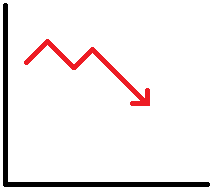The information on this page is not a personal recommendation and does not take into account your personal circumstances or appetite for risk.
Prices go down as well as up
Investors have a naturally positive bias, preferring to buy and hold shares, watching the price rise and their capital grow. This stems from the traditional share-dealing mindset. With CFDs and SpreadBetting, however, you are in a position to profit from both rising and falling prices on a host of products (Shares, FX, Indices, Commodities).
Profits when prices fall
When disaster strikes, as it did for BP in the Gulf of Mexico your immediate thought was likely for the lives of those on-board, and the environment. Understanding the mechanics of shares, however, I am sure you expected BP’s share price to fall. You understand that prices usually rise on good news and fall on bad news. If you know that profits can be made when prices rise, you’ll appreciate that they can also be made when prices fall.

“Short-selling”
This is the reverse of buying and holding and can be used to either hedge/offset existing positions/holdings against losses or indeed to take an outright negative view on the price.
Putting your naturally bullish focus aside and viewing things from a negative angle, if you expect a price to fall you can go Short rather than Long. Remember that for every buyer there needs to be a seller to facilitate the trade. In some cases the seller is closing out of a Long position (giving up, trade went wrong); in others he’ll be opening a new Short position (expecting the price to fall further). Short-selling actually helps keep markets liquid.
Just press Sell
It’s well known that prices tend to fall more quickly than they rise, with panic selling often gathering momentum, yielding significant returns in a short time-frame. ‘Shorting’ via CFDs or SpreadBetting is as easy as Buying or ‘going Long’. It just involves hitting the Sell button instead of Buy. Deposit requirements and leverage are the same, and risk can be managed int he same way with stop losses.
Warning!
Price rises will result in losses for a short position. Given that prices can rise to infinity, short-selling without the use of stop losses means are potentially infinite losses. Note that while FX, Indices and Commodities are highly liquid, short-selling of shares requires the shares be borrowed before being sold.
Risks include; short squeeze where heavily-shorted shares see a rush to buy back and settle up with the lender, squeezing the price higher very quickly while illiquid shares (low volumes) are more difficult to get in and out of.
Powerful tool
Many will choose to shun the option to trade Short, preferring not to contribute to a share price’s fall. However, with potential to profit from price movements, be they up or down, why restrict yourself to a unidirectional trading strategy and watch long positions suffer when markets fall.
Setting yourself up for a fall can be profitable. Get shorty!